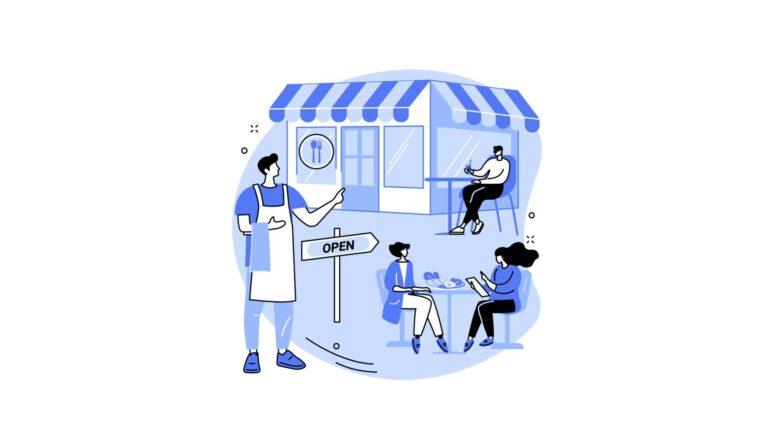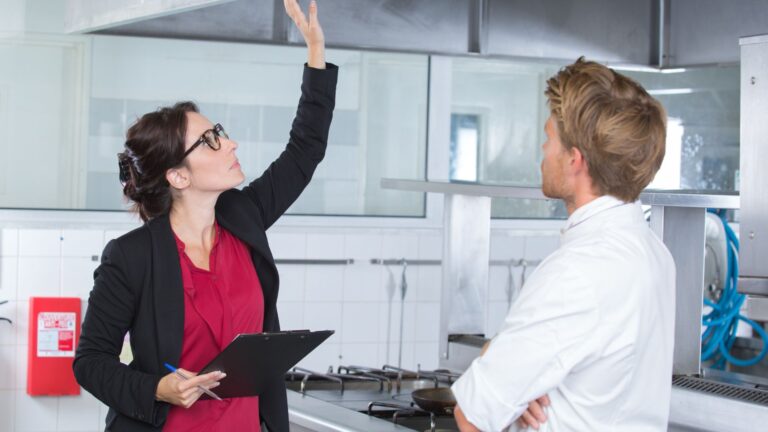Restaurant operations management is crucial for efficient service, consistent food quality, good hospitality, and financial success in the competitive restaurant industry. In this article, we’re going over the main components of restaurant operations plus our top tips for success.
Running a restaurant is more than just cooking and serving good food. As Wolfgang Puck said, “Being a great chef today is not enough–you have to be a great businessman.”
That’s why restaurant owners and managers need to understand everything that goes into restaurant operations management. From daily service to cooking the food, to purchasing equipment and training your staff, no restaurant can succeed without a strategic restaurant operations plan.
In this article, we’ll be discussing the main components of restaurant operations, plus our expert tips on how to ensure success.
Key Takeaways
- Restaurant operations management is crucial for ensuring smooth service and hospitality, customer satisfaction, and turning a profit.
- Investing in training is crucial for your team’s success.
- Take advantage of technology to help streamline operations, like scheduling, communication, inventory, and payroll.
- Meticulously track all financial transactions to reduce unnecessary spending and keep costs down.
What are Restaurant Operations?
Restaurant operations refer to all the ongoing, day-to-day tasks involved in keeping a restaurant up and running. Managing all of these is the key to turning a profit, retaining top talent, and, overall, running a successful restaurant.
This term includes everything from prepping and cooking food and taking inventory to training and scheduling your waitstaff. Everyone that works in a restaurant contributes to successful restaurant operations, but it’s up to owners and managers to make sure that the business is profitable and runs smoothly.
It’s important to develop strategies that ensure both front and back-of-house staff are aligned with business goals and that every single service runs smoothly.
Components of Restaurant Operations
There’s a lot that goes into running a successful restaurant, so let’s take a look at the primary components of what makes up restaurant operations:
Food preparation
No restaurant can function without a solid culinary team. Whether you run a fine dining establishment or a neighborhood bistro, you’ll need a head chef to lead your back-of-house staff.
They’ll be responsible for overseeing kitchen operations, including food handling and food safety, preparation, cooking, and plating. They’ll also need to ensure consistent quality, taste, and presentation of dishes.
As a result of inflated food costs and increased sustainability awareness, more and more restaurants are considering their environmental impacts. And according to Michelin, food waste reduction programs are coming in hot this year.
“How can we, as chefs, pretend to be passionate if we don’t care about the environment and, by very direct consequence, about the produce we need to cook nor the people we cook for?” head chef Amerigo Sesti of one-MICHELIN-starred J’AIME by Jean-Michel Lorain in Bangkok told the MICHELIN Guide.
Food For Thought:
Consider working with your chefs to create menu items that reduce food waste by utilizing all parts of the plants and animals they purchase. You may want to implement a composting program, too.
Creating schedules and compliance with labor laws
Depending on your restaurant, you may have several people creating weekly schedules. For example, the head chef or sous chef might be responsible for creating the kitchen staff schedule, while the assistant manager is responsible for scheduling the front-of-house staff.
However you do it, operational efficiency is key. Proper scheduling is important for many reasons, including:
- It allows you to maximize your staff’s abilities.
- You can keep labor costs in check by preventing overtime.
- Having a clear picture of your available staff makes it easier to plan for the unexpected. For example, if you have a sudden increase in reservations and need to call in extra staff or someone calls out last minute.
- Clear schedules prevent employee burnout and frustration, resulting in happier employees, increased productivity, and better hospitality.
- Schedules set clear expectations and hold staff accountable for completing assigned tasks.
Food For Thought:
Take advantage of an employee scheduling app to simplify the scheduling process and help you comply with labor and predictive scheduling laws.
Reduce scheduling errors, manage PTO, and approve shift swaps directly from your phone. You can also include tasks and checklists with each shift to increase overall productivity.
Staff training
Employee training is by far one of the most crucial aspects of restaurant operations. It’s essential to have a structured training program in place so every team member knows exactly what’s expected of them and how to carry out their daily tasks. It also helps them make better, more informed decisions.
Your training program should include a combination of on-the-job and digital training to provide a well-rounded overview of everything employees need to know, like menu items, steps of service, and how to properly use the POS system (You might also want to read our recent review of the best POS software for restaurants).
Create an employee handbook that establishes clear rules, values, and policies across the company to set standards and unify your staff. However, you’ll need customized training courses and materials for each position, too. After all, the expectations and skillsets for a server and a cook are going to be drastically different.
You might want to read our 10 Best Restaurant Training Courses.
Pro Tip
To help your team members better retain important information, upload training documents to an employee training app. That way, they don’t need to worry about losing paperwork, they can complete training modules on the go, and access it all directly from their phones.
Daily service
The beating heart of your restaurant is, of course, service. Whether you’re open for breakfast, lunch, or dinner (or all three), service needs to run like a well-oiled machine. This includes managing the dining room, greeting and seating guests, taking orders, serving food and beverages, handling customer inquiries or issues, and ensuring a pleasant dining experience.
One of the best ways to help ensure service runs smoothly is to hold pre-shift meetings.
Much like team huddles before a football game, preshift meetings allow you to pump your staff up and check in with them before a busy shift. Use this time to share important updates and announcements, the number of reservations on the books, answer questions, and allow staff to try any specials or new dishes on the menu.
Cleaning, sanitation, and safety
Day-to-day restaurant operations must include cleaning, sanitation, and safety protocol. Both the kitchen and dining room need to be cleaned regularly to maintain compliance with OSHA and your local health department (not to mention that a clean restaurant is simply more inviting and appealing to your guests). Your local government may also require certain employees to hold city-issued or ServSafe certifications.
To make sure cleaning gets done, incorporate it into employee sidework and closing procedures. Use an app to create simple, customized checklists to help both kitchen and front-of-house employees remember exactly what and how they need to clean at the end of their shifts.
Food For Thought:
With Connecteam, you can create your own digital forms and checklists and attach them to each shift on the schedule. Then, employees can check off tasks as they complete them right from their phones.
Managers can monitor tasks and make sure team members have completed their checklists at any time. You can also store cleaning or safety instructions in the employee Knowledge Base so the information is always available.
You may also be interested in downloading this free Restaurant Food Safety Checklist.
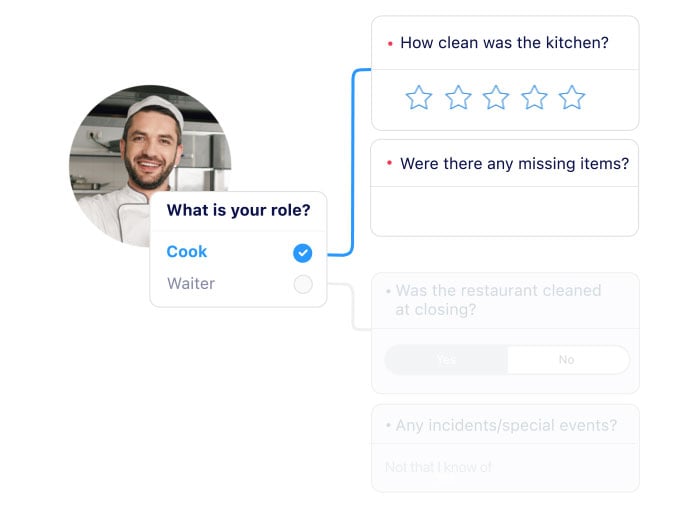
Payroll and financial management
Managers and chefs are usually responsible for maintaining food and labor costs, but you may want to hire an accountant or bookkeeper to help manage the financial side of things. They’ll be responsible for helping manage the restaurant budget and payroll, monitoring expenses, tracking revenues, and conducting profitability analyses.
Make sure to document all transactions and keep detailed records of everybody’s hours with an employee time clock. That way, employees are responsible for clocking in and out of their shifts from their phones, and everyone’s hours are automatically recorded onto timesheets. You can edit these as needed and export them directly to Excel or your payroll system.
Purchasing and inventory management
Conduct inventory on a regular basis and have a system in place to do so. Both the front and back of the house will be responsible for purchasing and maintaining inventory, so most likely, they’ll be multiple people in charge of this task.
Of course, the kitchen will spend the most on food inventory since they’re buying all of the ingredients. But you’ll need to purchase items for the front of house, too, which may include: alcohol and cocktail garnishes, takeout containers, plastic cutlery, paper napkins, office supplies, and coffee and tea.
Pro Tip
As a backup system, ask your staff to let you know if they notice the restaurant is running low on an item. Create a digital inventory form so employees to fill out an order request for items that are running low.
At the end of the shift, you can review these reports and use them to order new inventory for the next day, preventing your restaurant from running out of essential items.
6 Expert Tips for Successful Restaurant Operations Management
Here are 6 expert tips on how to improve restaurant operations management and increase your bottom line:
Hire the right people
Your employees are your most important resource, and your restaurant simply won’t function without a dedicated team. Here are some tips to help you hire the best team members for your restaurant:
- Define job roles and requirements: Clearly outline the positions you need to fill along with their specific responsibilities, complete job descriptions, and applicant qualifications. Include all of this information in the job advertisement to help reduce the number of unqualified applicants from applying.
- Review applications carefully: Carefully review all the resumes you receive and pay close attention to relevant experience and skills. Invite the most qualified candidates for interviews.
- Conduct practical assessments or stages: Depending on the position, consider conducting practical assessments or stages to evaluate applicants’ skills. For example, you might ask cooks to demonstrate their culinary skills or ask bartenders to create a few cocktails.
- Check references: Contact references to get a sense of an applicant’s work ethic, reliability, and performance in previous roles.
- Determine if candidates are a good cultural fit: Assess candidates’ compatibility with your restaurant’s culture and values during the interview process. Consider how they might work with the existing team and how they may contribute to a positive work environment.
This Might Interest You
Check out our in-depth article on how to effectively interview prospective candidates to ensure you hire qualified staff. Consider asking behavioral interview questions, too, to evaluate candidates’ abilities and experiences. Further we prepared interview questions for restaurant hirings.
Manage costs meticulously
Restaurants have one of the lowest profit margins of any industry, falling between an average of 3-5%. One of the most important restaurant management tips is to meticulously record and manage all of your costs. From equipment to food and labor costs, have a system in place to record and track all of your expenses.
If you hire an accountant or bookkeeper, work with them closely to monitor the restaurant’s finances. Keeping tabs on cash flow is key to running a profitable business and successful restaurant operations for the long term.
Utilize technology to streamline operations
Technology is crucial for managing restaurant operations because it allows you to store and manage all of your restaurant’s important information online. This keeps everything accessible and also automates processes like inventory, payroll, and online ordering.
Additionally, an employee management app, like Connecteam, is a restaurant manager’s secret weapon for overseeing their team and streamlining everything from scheduling to communication.
Here’s a few ways Connecteam can make restaurant business operations more efficient:
Simplified communication
Whether the chef is adding a new appetizer to the menu, 86ing a dish, or you need to relay scheduling changes to your waitstaff, you must have a way to reach all your team members. And in an industry that works on shifts, addressing your entire team in person just isn’t possible.
Not only does Connecteam allow you to keep work and personal messages separate, but you can create groups for each role in your restaurant, branded as Smart Groups, so you can message the relevant staff all at once. Or, post important announcements and updates on your company newsfeed so your team gets all the information they need to stay connected in an instant, right from their phones.
Streamlined scheduling and payroll
With Connecteam’s employee scheduling app, you have a clear overview of everyone’s work preferences and availability directly from the app. The system also alerts you of any errors in real time, such as double scheduling, preventing conflicts.
You can also assign specific tasks and include important notes and documents with each shift, so employees have all the relevant information they need to do their jobs. If you work with a delivery service, this can also be super helpful.
Connecteam also comes with employee scheduling templates to simplify the process even further and immediate notifications as soon as the schedule is published so staff can check it out immediately.
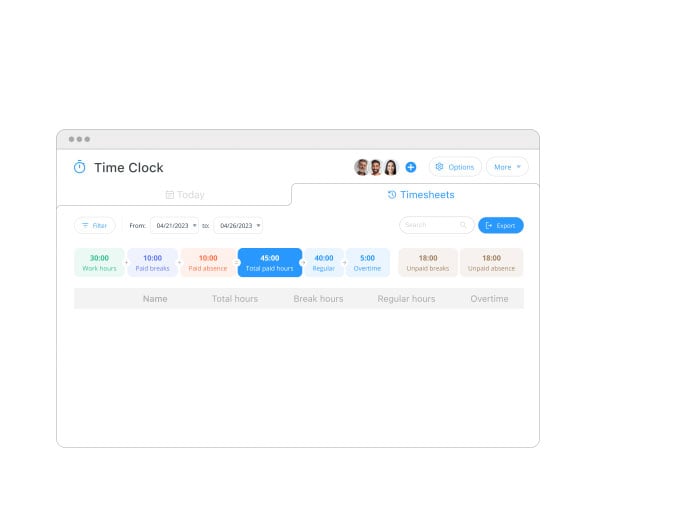
Easy task and sidework management
Ensure tasks and sidework checklists never get lost inside a dusty binder again by taking advantage of Connecteam’s checklist app. You can attach shift-specific checklists to assigned staff directly from the employee schedule to ensure they get done on time.
Workers can even check off tasks as they complete an item and let managers know when they’re finished. That way, you can be sure the sidework gets done each shift.
Use tailor-made restaurant templates
Connecteam provides tailor-made templates for reports, checklists, and other forms specifically designed for restaurants. By digitizing procedures such as pre-inspection, safety, and inventory checklists, you can easily automate procedures without much configuration. You can also create your own templates from scratch.
This Might Interest You
Download our free templates to streamline your daily workflows:
Keep all important documents in one easily accessible place
Connecteam’s Knowledge Base allows all your staff to access important documents like ingredient lists, menus, training manuals, and sidework checklists using their mobile devices or tablets. Additionally, they can easily share these documents with other staff, which can improve communication and collaboration among your entire team.
Invest in leadership training
Providing ongoing professional development courses for managers and chefs strengthens their sense of leadership within your restaurant. It also keeps them updated on industry trends, boosts skill levels, provides motivation, enhances customer service, and shows that you care about their professional development.
Managers can share their knowledge with their teams to help create a collaborative and supportive work environment. Doing so also creates a culture of continuous learning and improvement, which is important for employee retention.
Pro Tip
If you can’t get your restaurant managers in the same place at the same time, consider creating online professional development courses. You can upload the information to an employee training app like Connecteam so staff can complete the training at their own pace. You can even include videos and quizzes to test their knowledge and keep them engaged.
Focus on hospitality
A great restaurant isn’t just defined by the quality of the food; it’s the level of service that really makes it stand out. And while the average restaurant customer retention rate is rather low, sitting at about 55%, word of mouth is one of the best marketing tools you can have. Provide exceptional hospitality, and even one-time diners are going to tell their friends about it.
Therefore, customer service shouldn’t be an afterthought—it should be intertwined with your company culture and values.
Discuss the importance of hospitality from day one of employee training. You can also use pre-shift meetings to highlight real-world examples of both good and bad customer experiences in your restaurant. Hold open discussions on what lessons your team can learn and how to improve for next time.
You should also highlight and reward front-of-house staff who receive a glowing review or went above and beyond for a guest. Give them a shout-out on your company newsfeed app, provide a digital badge to show your appreciation, or even reward them with points that they can redeem for gift cards to their favorite retailers. You may even want to throw in a free bottle of wine as a thank you.
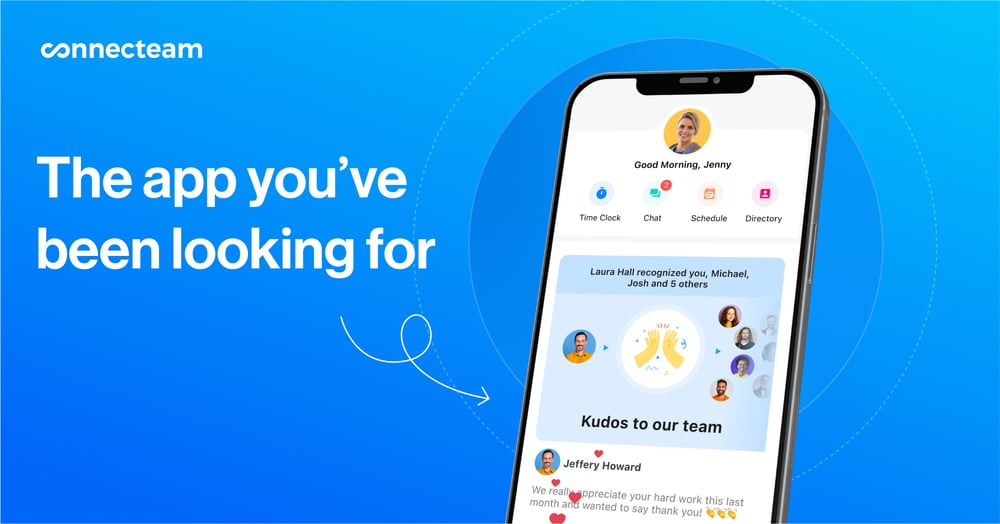
Create an operations manual
Often confused with an employee handbook, an operations manual is a document that lists all restaurant processes and procedures. It sets operational standards for your business and your team members, helps prevent mistakes, boosts operational efficiency and customer service, and helps reduce employee turnover. When new employees understand all restaurant procedures and policies, they are much more likely to stick around and succeed.
Keep your operations manual accessible by uploading it to an online Knowledge Base. That way, you won’t need to print a copy for each worker, and staff members can review the manual from their phones or tablets whenever they need a refresher.
Restaurant Operations Management is Essential for Success
Without a clear picture of every process that goes on in your restaurant, managers and restaurant owners won’t be able to run their businesses successfully. Properly managing your team, costs, inventory, and menus will result in a profitable restaurant.
In addition, make sure to incorporate the best technological solutions into your restaurant operations management. Connecteam, for example, is the best app for managing your employees on the go, in real time. It allows you to communicate, schedule, and manage all of your team members, whether they are physically in the restaurant or not.


